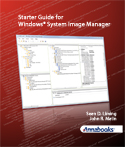
 |
 |
 |
 |
 |
 |
 |
 |
 |
Starter Guide for Windows® System Image Manager |
||||||||||||
By Sean D. Liming and John R. MalinNo Longer Available. Please see the new Start Guide for Windows 10 IoT Enterprise book. Windows® System Image Manager (SIM) allows PC Manufactures, IT Managers, and Embedded Developers to automate the installation of Windows operating systems. SIM allows these developers to install applications, device drivers, and Windows updates along with the Windows operating system. The ability to automate operating system installation helps to remove any human error that can occur with manual installation. Also, the ability to maintain and support many platforms over a long life cycle is an important asset in today’s ever changing technology. Starter Guide for Windows® System Image Manager covers all the basic functions of System Image Manager (SIM):
For Embedded Developers, architecting the Windows operating system is an important part of the image development process and critical for product life cycle support. The new Windows Embedded Industry (WEI) is being targeted at a wide range of embedded systems. To support these unique systems, WEI comes with a set of Lockdown features that can be enabled through SIM:
The book also covers third-party tools like SecureBus™ and real-time solutions from TenAsys® to secure and enhance the performance of Windows Embedded. The book brings all these elements together in nine chapters with 11 step-by-step exercises to create and architect Windows images into final systems. |
||||||||||||
Book DetailsPaperback: 162 Pages eBook Edition
|
|
|||||||||||
Software and Hardware RequirementsDevelopment system with Windows® 7 or higher Target Operating system installation DVD:
Target hardware platform or virtual machine to install images
|
Downloads:Book Exercises - Zip file contains files for use with exercises.
|
|||||||||||
Table of Contents: |
||||||||||||
|
1 DEPLOYMENTS-R-US 2 SIM OVERVIEW AND IMPLEMENTATION 3 ADDING TO THE DISTRIBUTION SHARE 4 SYSPREP 5 UPDATES AND IMAGE SERVICING |
6 WINDOWS EMBEDDED LOCKDOWN FEATURES 7 DEVICE EXPERIENCE FOR EMBEDDED SYSTEMS 8 SECURITY 9 REAL-TIME SUPPORT
|
|||||||||||
Related Books, Software, and Other Information |
||||||||||||
 |
Addendum 1: Windows 10 IoT Enterprise Build 10240 The addendum to the book covers Windows 10 IoT Enterprise and the changes from Windows Embedded 8.1 Industry. The addendum covers the product naming, changes to activation, new tools coming, changes to the Lockdown Features, code examples for customizing programmatic management of the Lockdown Features. |
|||||||||||
|
Please review our refund policy before buying. |
||||||||||||
|
|
||||||||||||
|
|
||||||||||||


